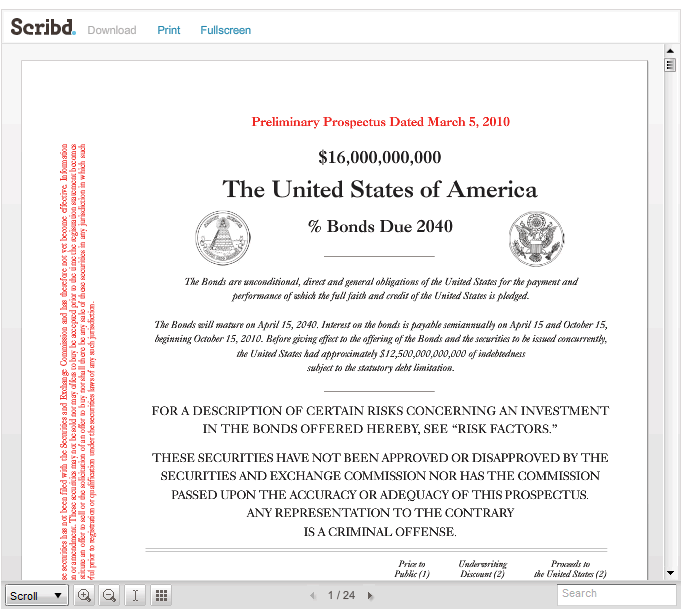U.S. Treasury Bonds Prospectus, Would You Invest?
Interest-Rates / US Bonds Apr 14, 2010 - 02:52 AM GMTBy: PhilStockWorld
 We talk a lot about the economy in abstract terms.
We talk a lot about the economy in abstract terms.
On the other hand, many of us are well-versed at going over a prospectus and Jim Grant of the Interest Rate Observer has put one together for the United States of America as it seeks to raise $16Bn for 30-year Treasury Notes. According to the prospectus: "The Bonds will mature on April 15, 2040. Interest on the bonds is payable semiannually on April 15 and October 15, beginning October 15, 2010. Before giving effect to the offering of the Bonds and the securities to be issued concurrently,the United States had approximately $12,500,000,000,000 of indebtedness subject to the statutory debt limitation."
 The United States Government (“the Government”) employs 2.8 million civilians and a further 1.4 million active duty military personnel. The Government holds title to 650 million acres of land, 3.3 billion square feet of building assets and numerous other assets. Public lands account for 5% and 11%, respectively, of America’s onshore oil and gas production, and 41% of its coal production. The Department of the Interior is responsible for the management of 1.76 billion acres of the Outer Continental Shelf that contain over 8,000 active mineral leases.
The United States Government (“the Government”) employs 2.8 million civilians and a further 1.4 million active duty military personnel. The Government holds title to 650 million acres of land, 3.3 billion square feet of building assets and numerous other assets. Public lands account for 5% and 11%, respectively, of America’s onshore oil and gas production, and 41% of its coal production. The Department of the Interior is responsible for the management of 1.76 billion acres of the Outer Continental Shelf that contain over 8,000 active mineral leases.
As a result of the economic downturn and the decade-long shortfall of Government receipts compared to Government pending, the Government has run, and will continue to run, substantial deficits. In fiscal 2009, the unified budget deficit (the “Deficit”) was $1.41 trillion, or 9.9% of GDP, compared to the fiscal 2008 Deficit of $459 billion, or 3.2% of GDP. The Congressional Budget Office (the “CBO”) projects the Deficit to decline slightly in fiscal 2010 to $1.35 trillion, or 9.2% of GDP. However, the Government is projected to run continued large deficits.
As a result of the financial crisis and insolvency of the Federal National Mortgage Association (“Fannie Mae”) and the Federal Home Loan Mortgage Corp. (“Freddie Mac”), as well as the implicit Government guarantee on large financial institutions, the Government is exposed to substantial credit risk.
The tables summarizing our accounts are, of course, terrifying but nothing compared to our Risk Factors, which include:
 Improper payments by the Federal government continue to increase despite the Improper Payments Information Act of 2002.
Improper payments by the Federal government continue to increase despite the Improper Payments Information Act of 2002.- Material weakness from ineffective internal controls over financial reporting that resulted in a
- disclaimer of opinion by the Government Accountability Office.
- The dollar may not continue to enjoy reserve currency status and may decline in the future.
- The Federal Reserve, as part of its response to the financial crisis, may be exposed to signifcant
- credit risk.
- Foreign official institutions hold a significant amount of U.S. Government debt.
- The United States is the dominant geopolitical power and has significant overseas commitments.
- The Government is exposed to large contingent liabilities from its intervention on behalf of various financial institutions during the 2008-2009 crisis.
- Mandatory outlays for retirement insurance and health care are expected to increase substantially in future years.
- Ratings agencies may withdraw or downgrade the U.S. Government’s current AAA/Aaa rating without notice.
- The U.S. economy is heavily indebted at all levels, despite recent de-leveraging.
- U.S. states and municipalities are experiencing severe economic distress and may require intervention from the Federal government.
- Elected officials may not take necessary steps to ensure long-term debt sustainability and may take actions counter to the interests of bondholders.
Under the section entitled "Management’s Discussion and Analysis of Financial Condition and Results of Operations" we have some postive notes on growth (GDP) and improving conditions for the Financial Markets as credit spreads have contracted 222 basis points from their high of 473 in November of 2008 with US corporations raising $1.1Tn in debt (much of it from the Government) and $267Bn in equity financing in 2009 but real estate remains a continuing area of concern:
The housing market remains under stress. New-home sales are currently running at a 309,000 annual rate, the lowest on record, down 78% from the peak and below the 896,000 10-year average. Existing-home sales have recovered slightly as a result of tax incentives and are running at a five million annual rate, below the 10-year average of 5.83 million and well below the high of 7.25 million. House prices, as measured by the S&P/Case-Shiller Composite-20 Index, appear to have stabilized somewhat, increasing by 4.8% between April 2009 and December 2009. House prices remain 29% below their spring 2006 peak.
Mortgage credit quality continues to deteriorate. Serious delinquencies increased to an all-time high of 9.67% of all mortgages in the fourth quarter of 2009, compared to 6.30% a year earlier and 3.62% at the end of 2007. Prime serious delinquencies increased to 7.01% in the fourth quarter, compared to 3.74% a year earlier and 1.67% at the end of 2007. More broadly, credit quality in other types of real estate loans, especially commercial real estate, also continues to deteriorate. Delinquency rates in commercial real estate loans at commercial banks increased to 8.81% in the fourth quarter, compared to 5.53% a year earlier and 2.77% at the end of 2007.
The same section has a neat summary of of our current debt picture:
Government finances remain under stress. Fiscal 2009 receipts declined by 16.6%, to $2.1 trillion from $2.5 trillion in fiscal 2008. In the first four months of fiscal 2010, receipts dropped by a further 10.4% from the prior-year period. Receipts as a percentage of GDP declined to 14.8% in fiscal 2009, the lowest level since 1950. On-budget receipts (excluding Social Security) were 10.2% of GDP in fiscal 2009, the lowest level since 1943. Individual income tax collections dropped by 20%, while corporate income tax collections dropped by 55%. Medicare and Social Security payroll tax collections declined for the first time since 1946.
Government outlays increased by 18% in fiscal 2009, to $3.5 trillion from $2.98 trillion in fiscal 2008, as a result of the response to the financial crisis and recession. As a percentage of GDP, outlays increased to 24.7%, the highest level since 1946 and above the previous high of 23.5% in 1983. Through the first four months of fiscal 2010, outlays decreased by 3.8% from the year-earlier period.
As a result of the increase in spending and decrease in tax revenues, the Government deficit increased to $1.4 trillion in fiscal 2009 from $459 billion the prior year. The Deficit was 9.9% of GDP, the highest since 1945. The Treasury borrowed extensively to fund Government operations, and the debt held by the public increased to $7.54 trillion at the end of 2009. Debt held by the public was 53% of GDP at the end of 2009, the highest since 1955. Since the year 2000, Government debt held by the public has increased by $4.1 trillion, or 18.3% of GDP.
Under the final section, titled "Liquidity and Capital Resources," we get a nice overview of the road ahead for our funding needs: "The current Treasury funding plan calls for roughly $1.4 trillion of marketable borrowing in fiscal 2010. The Treasury plans to auction $392 billion of net marketable debt in the fiscal second quarter and $268 billion in the third. The Treasury believes that the size of the auctions gives it the ability to address adequately a broad range of financing needs. It has increased the average maturity of issuance from under 30 months in 2002 to more than 70 months as of the fourth quarter of 2009; as a result, the average maturity of all debt outstanding has steadily increased to almost 55 months. Over the next 10 years, the Treasury expects the average maturity of debt issuance to increase to 79 months and the average maturity of all debt outstanding to increase to 68 months."
It’s a very clever document (thanks to Sportivny at Seeking Alpha for pointing it out) and a great way of looking at our financial situation in a format we investors are more used to. As earnings season progresses, it will be interesting to compare this prospectus to the quarterly statements of our S&P 500 companies - perhaps someone can rank America, Inc. compared to the rest of the list? Here’s Jim Grant discussing the prospectus and, of course, concluding that it is very likely that rates will rise in 2010:
By Phil
Philip R. Davis is a founder of Phil's Stock World (www.philstockworld.com), a stock and options trading site that teaches the art of options trading to newcomers and devises advanced strategies for expert traders. Mr. Davis is a serial entrepreneur, having founded software company Accu-Title, a real estate title insurance software solution, and is also the President of the Delphi Consulting Corp., an M&A consulting firm that helps large and small companies obtain funding and close deals. He was also the founder of Accu-Search, a property data corporation that was sold to DataTrace in 2004 and Personality Plus, a precursor to eHarmony.com. Phil was a former editor of a UMass/Amherst humor magazine and it shows in his writing -- which is filled with colorful commentary along with very specific ideas on stock option purchases (Phil rarely holds actual stocks). Visit: Phil's Stock World (www.philstockworld.com)
© 2010 Copyright PhilStockWorld - All Rights Reserved Disclaimer: The above is a matter of opinion provided for general information purposes only and is not intended as investment advice. Information and analysis above are derived from sources and utilising methods believed to be reliable, but we cannot accept responsibility for any losses you may incur as a result of this analysis. Individuals should consult with their personal financial advisors.
© 2005-2022 http://www.MarketOracle.co.uk - The Market Oracle is a FREE Daily Financial Markets Analysis & Forecasting online publication.





